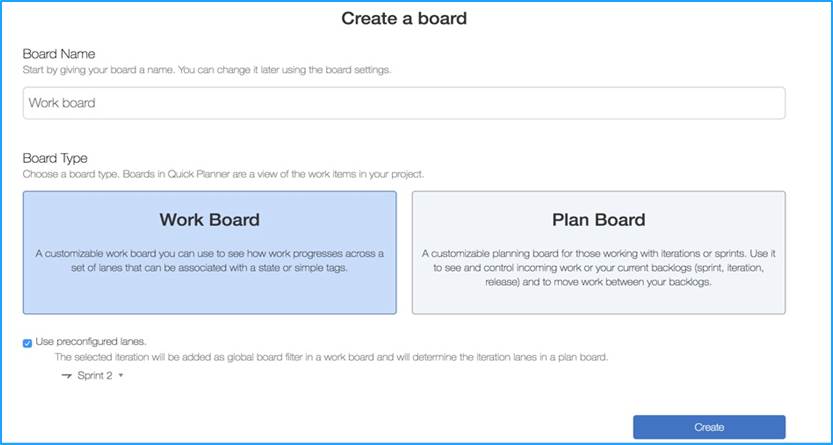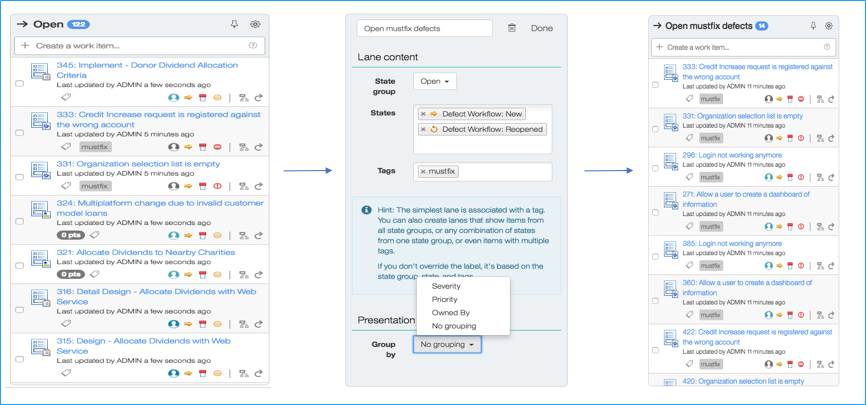We’ve been busy working on three major themes in IBM Rational Team Concert (RTC) 6.0.5 :
- Ease of Use: Make it super easy to create task boards or plan boards using both tag based and/or process based swim lanes with an all new RTC Quick Planner UI built from the ground up in REACT.
- Data Scalability: Allow development teams to version extremely large files using an external enterprise file store like Artifactory so they can manage growth of versioned data without inflating the RTC SCM database. We also did data scalability testing to expand the number of supported RTC SCM components significantly.
- Compliance and Traceability: Enhanced support for electronic signatures for regulated teams who require electronic signature audit control. Support for keyword expansion in RTC SCM allows teams to insert useful data to support auditing or version management into RTC SCM versioned files. Enhanced traceability between Rhapsody models and RTC work items so you can see designs, tasks and code in one place.
Below is a summary of each, along with a description of some integration enhancements that we’ve made.
Ease of Use: All new IBM RTC Quick Planner built using REACT
I always hear from customers that they love RTC’s rich process customization and the ability to share process across all their teams. In the next breath, I usually hear that customers want RTC to be easier to use for new users. In RTC v6.0.5, we have delivered a completely new Rational Team Concert (RTC) Quick Planner that now supports flexible tag and process-based task boards and planning boards. It’s simple to add, re-order or rename swim lanes using simple tags or a combination of process and tags. Users can now easily add swim lanes to track work items using tags, while still adhering to process states to roll up status and ensure quality. Now you get the simplicity of tag based boards combined with the process control and sharing of RTC. We also implemented a lot of improvements based on feedback we’ve received since the RTC Quick Planner Next technical preview was released in RTC 6.0.4.
As you can see in Figure 1: above, when you create a new board in RTC Quick Planner, you now have two options:
- To create a work board, which is essentially a task board showing how your work is progressing using states or tags or a combination of the two. You can use work boards to easily create a “My work view” using board filters that select only work assigned to you, for example.
- To create a plan board. This is analogous to the “Iteration Planning Board” for managing sprints and your product backlog. In this release, plan boards are much more flexible since you can now combine both your process states with new tag based swim lanes or even combine the two in a single lane.
One way to think about the new RTC Quick Planner is prior to RTC v6.0.5, everything in RTC Quick Planner that was in a swim lane had to have a process state in XML that defined it. So if a development team wanted to experiment with a new state, they had to modify the process template prior to RTC v6.0.5 to make it appear in the swim lane.
Now, with RTC v6.0.5 Quick Planner, you can add new experimental states such as “waiting for test” and make that swim lane tag-based. It is now possible to have a 100% process state-based board or a 100% tag-based board (with no process behind it – like GitHub issues or Trello has) or more likely, a combination of both process and tag-based lanes in your board. So think of the possibilities this allows. I can have a “corporate process template” that has 4 or 5 states that every team must have to report consistently on project status across all teams. But then, if one team wants to experiment with a “waiting for test” state, they can easily do that by simply adding a tag-based lane to their boards using tags. You get the best of both worlds... the process control and customization of RTC, with the simplicity and flexibility of tag-based lanes for developers to innovate and experiment with new agile methods or simply track important work items and to-do’s using tags.
Here’s another use case to ponder. As can be seen in Figure 2, suppose you wanted to create a swim lane that only shows defect states in the Open state group with the #mustfix tag. In the blue lane, you see the dialog for modifying what the swim lane shows. You can rename the lane, add a tag ,and select individual states such as “defect workflow:New or Reopened” to get the desired outcome on the right for your swim lane. RTC Quick Planner in v6.0.5 is very flexible and it makes it easy for teams to produce boards that match their desire without having to modify the process template. So the next time a team comes to you and asks, “How do I create a board that matches my physical board with yellow stickies for tracking important team issues?”, you can point them to RTC Quick Planner and show them how easy it is to create the board they want.
Some other nice enhancements we made include the ability to support very large screens and display up to 8 lanes, as well as the ability to pin down more than one lane. And the user experience is very fast built on REACT, which allows for deferred execution of tasks, so you don’t wait for a background task to complete before the next UI gesture is requested from the user. Facebook and Instagram both use REACT technology to give nearly instantaneous UI response to users actions with modular updates to only the parts of the UI that have changed, rather than having to refresh the entire UI. So tell us what you think of our fast and flexible RTC Quick Planner.
To see it in action, watch this new demo video of RTC v6.0.5 Quick Planner.
Data Scalability: Version very large files and projects with thousands of components
In complex application development, you often need to version and store more than just code. You might have very large models or product data files that still need to be versioned as part of your development work space. But at the same time, you don’t want to store really huge binary or other files in your RTC database and drastically increase the size of it.
In RTC 6.0.5, you can now store files outside of the RTC database and in the local file system or in a WebDAV compatible server file store such as Artifactory. You can specify a file size (for example >10 MB) that you wish to be stored in an external file store. Then all new files checked into RTC SCM will follow this rule for storage going forward.
In this release, it is also possible to extract existing large files and place them in your external store using the “repotools” command. Your developers work as usual and the storage of the file is transparent to them. You would configure external store only for larger files as there is some fixed overhead in moving and retrieving the file from an external store. Your backup strategy also needs to adjust to address storing data in two places.
We did some work in this release to test RTC SCM at scale with projects containing up to 2,500 components. We have increased the recommendation to allow projects to scale that need thousands of components. So your next big project can use RTC SCM to get the job done while maintaining centralized visibility into changes across teams.
Compliance and Traceability: Enhanced electronic signatures and RTC SCM keyword expansion
We all rely on software to control critical capabilities like emergency braking in our cars, pacemaker rhythms in our bodies, temperature control for people and food, and critical financial transactions. As our dependence on software quality grows, the cost of a defect also grows. When the cost of a defect is very high, your software development relies on achieving higher quality and avoiding accidental or malicious changes to software that could cost your company its reputation. In this release, we have enhanced RTC electronic signatures to require both a user name and password on approval, store the signature in the work item history for audit purposes, and allow you to query on the status of electronic signature approvals.
In RTC v6.0.5, we have also added support for RTC SCM “Keyword Expansion” to allow teams to insert pieces of useful, dynamic information about a versioned file into the contents of the file itself. Keyword expansion is handy for tracking the last modification date of a file or other useful information. Older file-based versioning systems like CVS and Subversion support keyword expansion so this is also helpful when migrating code or build processes that rely on keyword expansion from those tools to RTC SCM.
- Supported Keywords Include:
$Name$ – The name of the file in the repository.
$Date$ – The date that the file in the repository was most recently modified.
$VersionId$ – The version ID of the file.
$LongVersionId$ – The long version ID of the file (for example: VersionId@repoId).
$ItemId$ – The UUID that identifies the file.
$StateId$ – The UUID that identifies the specific state of the file.
Enhanced Traceability: Link Rhapsody Design artifacts to RTC work items
Using Global Configurations, you can now navigate a link in a work item in RTC to an artifact in Rhapsody Design Manager (RDM) with resolution of an “Elaborated by Architecture Element” link to the correct version of the design artifact.
Enhanced Integrations
GitLab, GitHub and RTC work items and planning
In large organizations, it is common to have multiple version control tools for different needs. For example, in IBM we have teams who develop open source-based, social coding projects like Blockchain. These teams might use Git, GitLab or GitHub for example. Other teams in IBM manage multiple variants of their software in complex regulated environments, and for those projects, they require RTC SCM to manage change centrally. In both cases, you might want one tool to manage work items and planning across development projects in your company regardless of the version control tool you use for a given project.
So what have we improved? For GitHub, now when a work item is mentioned in an issue or commit discussion, a link is added to the work item. For GitLab,
- When you commit a change in GitLab, it adds links to all the RTC work items mentioned in the comment.
- Comment triggers – when a RTC work item is mentioned in an issue or commit discussion, a link is added to the work item.

Jenkins integration to RTC SCM
For the latest enhancements to our Jenkins integration, see the Team Concert Plugin for Jenkins site. We’ve added load rule support to this popular plug-in in the most recent release 1.2.0.4 released on December 4, 2017, along with other features.
I’ve covered some of the more visible features here. For a complete list of enhancements, see RTC v6.0.5 New and Noteworthy Details. New users can try RTC in our new Previews tool or in a cloud trial. More experienced users can download RTC from here.
Let us know what you think about our latest release. RTC v6.0.5 should help you on board teams faster with its new tag and process based work and plan boards. Enjoy!
Rolf Nelson
RTC Product Manager
Ask questions on the Jazz.net forum. Stay connected with Jazz.net on Facebook and Twitter. Watch us on YouTube.












































































































































































You must be logged in to post a comment.